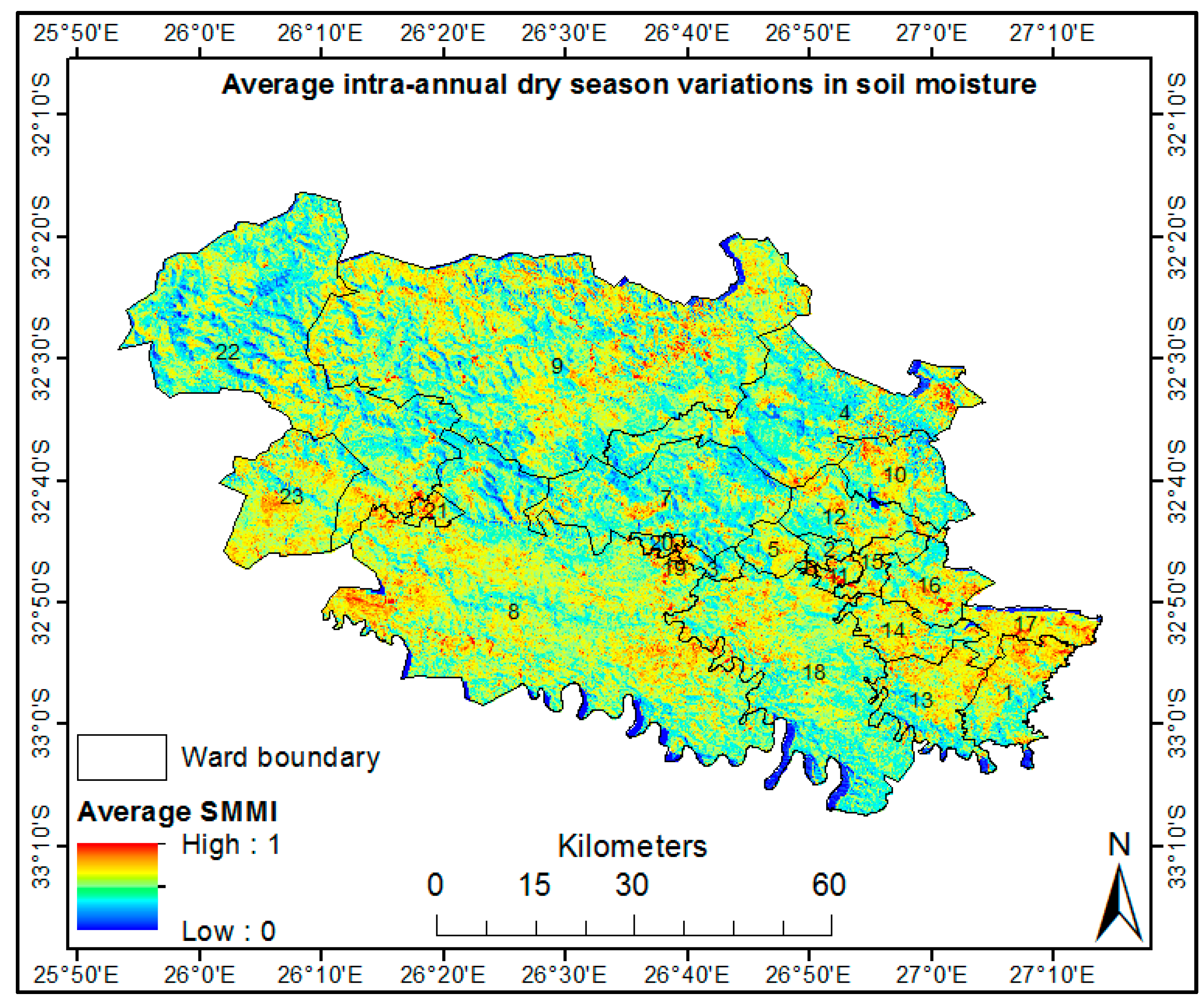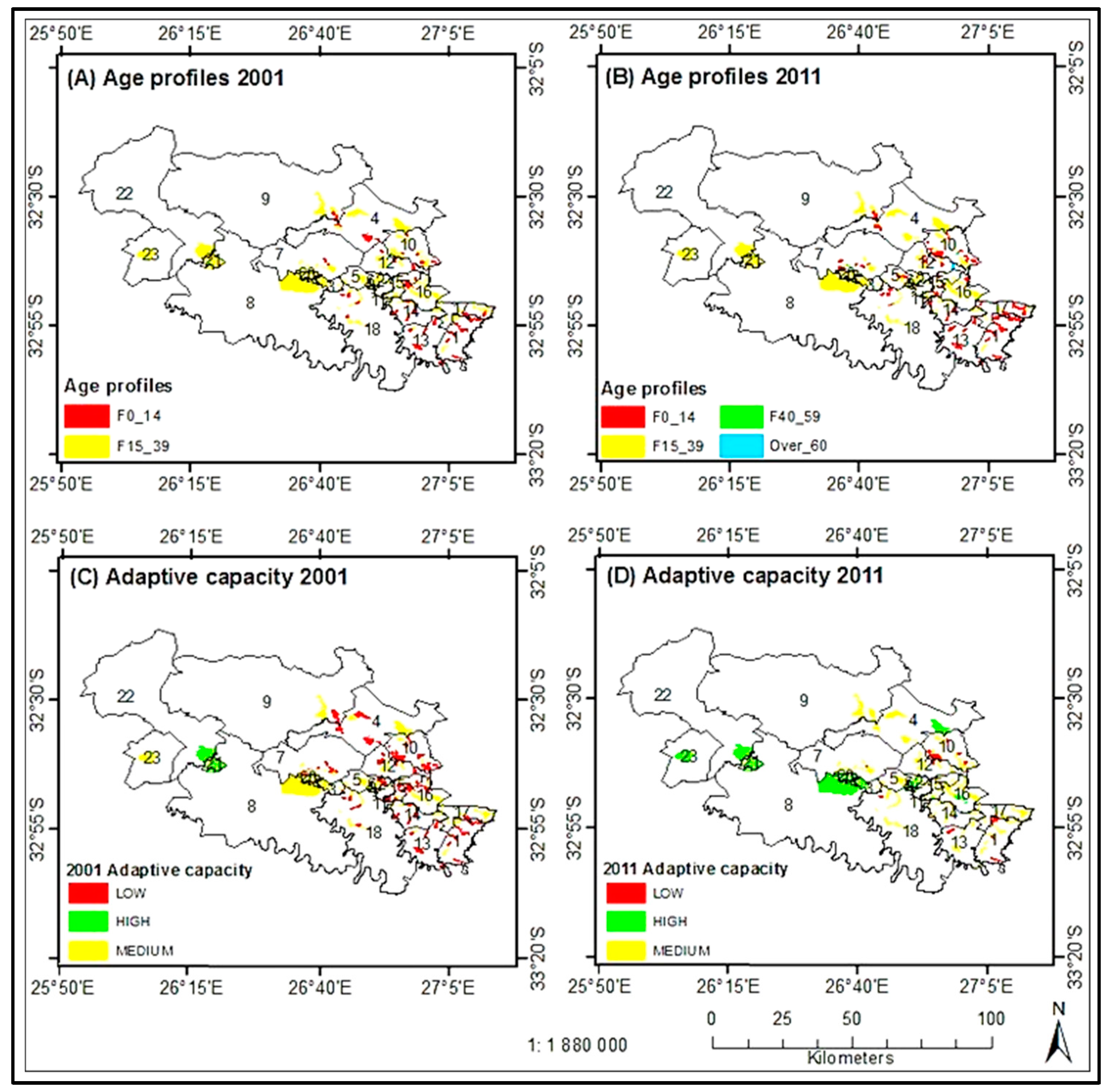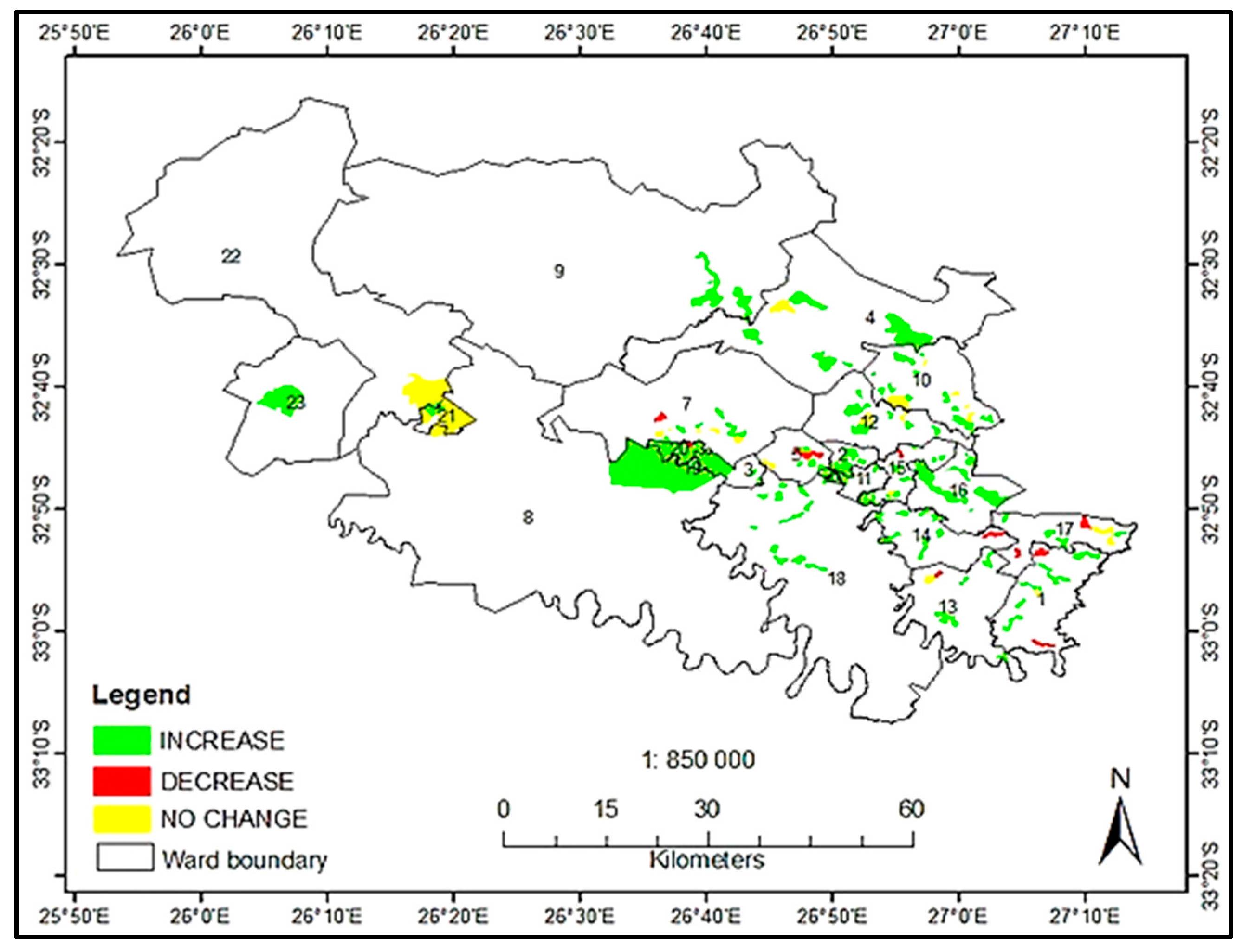Linking Satellite, Land Capability, and Socio-Economic Data for Local-Level Climate-Change-Adaptive Capacity Assessments and Decision Support
Abstract
:1. Introduction
2. Materials and Methods
2.1. Study Area
2.2. Data and Methods
- Demographic data;
- Land capability data;
- In situ soil moisture data;
- SPOT images of 2014, 2015, 2016, and 2017.
- Space–time trend modelling;
- Empirical covariance estimation;
- Space–time dependence analysis;
- BME-based spatiotemporal prediction and mapping;
- Geostatistical-based land capability map compilation and adaptive capacity mapping.
2.2.1. Soil Moisture
2.2.2. Land Capability
2.2.3. Socio-Economic Data Category
| Algorithm 1. Calculating final adaptive capacity using average soil moisture, arable lands, and socio-economic data |
| START Verify availability of arcpy module Input:
Add fields to the input table for storing the total adaptive capacity score and the final adaptive capacity rating:
Iterate through each row in the table using an arcpy.da.UpdateCursor:
Output:
|
3. Results
- (a)
- (b)
- Spatial distributions of arable/marginal lands and locations of nearby communities (Figure 5);
- (c)
- Access to water and literacy, income levels, age profiles and adaptive capacities, adaptive capacity changes between 2001 and 2011, and final adaptive capacities of communities based on arable lands, soil moisture information, and socio-economic indicators (Figure 6, Figure 7, Figure 8 and Figure 9);
- (d)
3.1. Intra-Annual Dry Season Variations in Soil Moisture
3.2. Spatial Distributions of Arable/Marginal Lands and Locations of Nearby Communities
3.3. Access to Water and Literacy and Income Levels, Age Profiles, and Adaptive Capacities
3.4. Communities with Declining and Static Adaptive Capacities
4. Discussion
4.1. Soil Moisture
4.2. Arable Lands
4.3. Access to Water
4.4. Literacy Levels
4.5. Annual Income Levels
4.6. Impact of Age Distributions on Resilience
5. Recommendations and Conclusion
5.1. Recommendations
5.2. Conclusions
Supplementary Materials
Author Contributions
Funding
Institutional Review Board Statement
Informed Consent Statement
Data Availability Statement
Acknowledgments
Conflicts of Interest
References
- Naulleau, A.; Gary, C.; Prévot, L.; Hossard, L. Evaluating strategies for adaptation to climate change in grapevine production—A systematic review. Front. Plant Sci. 2021, 11, 2154. [Google Scholar] [CrossRef]
- Dasgupta, S.; Badola, R.; Ali, S.Z.; Jiju, J.S.; Tariyal, P. Adaptive capacity and vulnerability of the socio-ecological system of Indian Himalayan villages under present and predicted future scenarios. J. Environ. Manag. 2022, 302, 113946. [Google Scholar] [CrossRef]
- Tran, P.T.; Vu, B.T.; Son, T.; Ngo, S.T.; Tran, V.D.; Ho, T.D.N. North Central Region of Vietnam: A Case Study in Nghe an Province, Vietnam. Environ. Chall. 2022, 7, 100460. [Google Scholar] [CrossRef]
- Islam, M.S.; Samreth, S.; Hayat-Md, A.; Islam, S.; Sato, M. Climate Change, Climatic Extremes, and Households’ Food Consumption in Bangladesh: A Longitudinal Data Analysis. Environ. Chall. 2022, 7, 100495. [Google Scholar] [CrossRef]
- Babakholov, S.; Bobojonov, I.; Hasanov, S.; Glauben, T. An Empirical Assessment of the Interactive Impacts of Irrigation and Climate on Farm Productivity in Samarkand Region, Uzbekistan. Environ. Chall. 2022, 7, 100502. [Google Scholar] [CrossRef]
- Masuda, Y.J.; Castro, B.; Aggraeni, I.; Wolff, N.H.; Ebi, K.; Garg, T.; Game, E.T.; Krenz, J.; Spector, J. How Are Healthy, Working Populations Affected by Increasing Temperatures in the Tropics? Implications for Climate Change Adaptation Policies. Global Environ. Chang. 2019, 56, 29–40. [Google Scholar] [CrossRef]
- Ford, J.D.; Berrang-Ford, L.; Biesbroek, R.; Araos, M.; Austin, S.E.; Lesnikowski, A. Adaptation tracking for a post-2015 climate agreement. Nat. Clim. Chang. 2015, 5, 967–969. [Google Scholar] [CrossRef]
- Berrang-Ford, L.; Biesbroek, R.; Ford, J.D.; Lesnikowski, A.; Tanabe, A.; Wang, F.M.; Chen, C.; Hsu, A.; Hellmann, J.J.; Pringle, P.; et al. Tracking global climate change adaptation among governments. Nat. Clim. Chang. 2019, 9, 440–449. [Google Scholar] [CrossRef]
- Lesnikowski, A.; Ford, J.; Biesbroek, R.; Berrang-Ford, L.; Maillet, M.; Araos, M.; Austin, S.E. What does the Paris Agreement mean for adaptation? Clim. Policy 2017, 17, 825–831. [Google Scholar] [CrossRef]
- Ford, J.; Berrang-Ford, L.; Lesnikowski, A.; Barrera, M.; Heymann, S. How to track adaptation to climate change: A typology of approaches for national-level application. Ecol. Soc. 2013, 18, 40. [Google Scholar] [CrossRef]
- Orusa, T.; Viani, A.; Moyo, B.; Cammareri, D.; Borgogno-Mondino, E. Risk Assessment of Rising Temperatures Using Landsat 4–9 LST Time Series and Meta Population Dataset: An Application in Aosta Valley, NW Italy. Remote Sens. 2023, 15, 2348. [Google Scholar] [CrossRef]
- de Sherbinin, A. Climate change hotspots mapping: What have we learned? Clim. Chang. 2014, 123, 23–37. [Google Scholar] [CrossRef]
- ADM. Amathole District Municipality 2017–2020 Integrated Development Plan (IDP)-Eastern Cape Socio Economic Consultative Council (ECSECC). 2017. Available online: https://www.ecsecc.org/information-centre/item/amathole-2017-2020-integrated-development-plan-idp (accessed on 16 November 2022).
- Local Government Handbook. The Local Government Handbook: South Africa. 2016. Available online: http://www.localgovernment.co.za/locals/view/233/Raymond-Mhlaba-Local-Municipality (accessed on 27 February 2023).
- Chari, M.M.; Hamandawana, H.; Zhou, L. Socioeconomically informed use of geostatistics to track adaptation of resource-poor communities to climate change. In African Handbook of Climate Change Adaptation; Leal Filho, W., Oguge, N., Ayal, D., Adeleke, L., da Silva, I., Eds.; Springer International Publishing: Cham, Switzerland, 2021; pp. 1555–1581. [Google Scholar] [CrossRef]
- Ncube, M.; Madubula, N.; Ngwenya, H.; Zinyengere, N.; Zhou, L.; Francis, J.; Mthunzi, T.; Olivier, C.; Madzivhandila, T. Climate change, household vulnerability and smart agriculture: The case of two South African provinces. Jàmbá J. Disaster Risk Stud. 2016, 8, 6–8. [Google Scholar] [CrossRef]
- Available online: https://eos.com/spot-6-and-7/ (accessed on 12 September 2021).
- Liu, Y.; Yue, H.; Wang, H.R.; Zhang, W. Comparison of SMMI, PDI and its applications in Shendong mining area. IOP Conf. Ser. Earth Environ. Sci. 2017, 57, 012025. [Google Scholar] [CrossRef]
- Black, C.A. Methods of Soil Analysis. Part 1. Physical and Mineralogical Properties; American Society of Agronomy: Madison, WI, USA, 1965. [Google Scholar]
- Yue, H.; Liu, Y.; Qian, J. Soil moisture assessment through the SSMMI and GSSIM algorithm based on SPOT, WorldView-2, and Sentinel-2 images in the Daliuta Coal Mining Area, China. Environ. Monit. Assess. 2020, 192, 237. [Google Scholar] [CrossRef] [PubMed]
- Chari, M.M.; Hamandawana, H.; Zhou, L. A proposed methodology to map soil moisture in support of farm-level decision making under changing climatic conditions. In Sustainable Agriculture and Food Security; Leal Filho, W., Kovaleva, M., Popkova, E., Eds.; World Sustainability Series; Springer: Cham, Switzerland, 2022. [Google Scholar] [CrossRef]
- Available online: https://stemlab.bse.ntu.edu.tw/blog/2019-04-23-star-bme/ (accessed on 14 March 2022).
- Han, L.; Wang, C.; Liu, Q.; Wang, G.; Yu, T.; Gu, X.; Zhang, Y. Soil moisture mapping based on multi-source fusion of optical, near-infrared, thermal infrared, and digital elevation model data via the Bayesian Maximum Entropy framework. Remote Sens. 2020, 12, 3916. [Google Scholar] [CrossRef]
- Mouazen, A.M.; Shi, Z. Estimation and mapping of soil properties based on multi-source data fusion. Remote Sens. 2021, 13, 978. [Google Scholar] [CrossRef]
- Wang, C.; Xie, Q.; Gu, X.; Yu, T.; Meng, Q.; Zhou, X.; Han, L.; Zhan, Y. Soil moisture estimation using Bayesian Maximum Entropy algorithm from FY3-B, MODIS and ASTER GDEM remote-sensing data in a maize region of HeBei Province, China. Int. J. Remote Sens. 2020, 41, 7018–7041. [Google Scholar] [CrossRef]
- Jian, X.; Olea, R.A.; Yu, Y.S. Semi-variogram modeling by weighted least squares. Comput. Geosci. 1996, 22, 387–397. [Google Scholar] [CrossRef]
- Barber, M.; Grings, F.; Perna, P.; Piscitelli, M.; Maas, M.; Bruscantini, C.; Jacobo-Berlles, J.; Karszenbaum, H. Speckle noise and soil heterogeneities as error sources in a Bayesian soil moisture retrieval scheme for SAR data. IEEE J. Sel. Top. Appl. Earth Obs. Remote Sens. 2012, 5, 942–951. [Google Scholar] [CrossRef]
- Nkonkobe Local Municipality. Integrated Development Plan 2012–2017. 2012. Available online: http://nkonkobe.gov.za/?q=system/files/filedepot/2/FINAL/IDP/2012-2017.pdf (accessed on 15 February 2023).
- Darkoh, M.B.K. The Nature Causes and Consequences of Desertification in the Drylands of Africa. Land Degrad. Desertif. 1998, 9, 1–20. [Google Scholar] [CrossRef]
- Darkoh, M.B.K. Regional Perspectives on Agriculture and Biodiversity in the Drylands of Africa. J. Arid Environ. 2000, 54, 261–279. [Google Scholar] [CrossRef]
- Darkoh, M.B.K. Agriculture and Biodiversity in the Drylands of Africa. In Human Impact on Environment and Sustainable Development in Africa: Contemporary Perspectives on Developing Societies; Darkoh, M.B.K., Rowmire, P., Eds.; Ashgate Publishing Ltd.: Hampshire, UK, 2003; pp. 253–281. [Google Scholar]
- Ponkina, E.; Illiger, P.; Krotova, O.; Bondarovich, A. Do ARMA models provide better gap filling in time series of soil temperature and soil moisture? The case of arable land in the Kulunda Steppe, Russia. Land 2021, 10, 579. [Google Scholar] [CrossRef]
- Tiefenbacher, A.; Weigelhofer, G.; Klik, A.; Mabit, L.; Santner, J.; Wenzel, W.; Strauss, P. Antecedent soil moisture and rain intensity control pathways and quality of organic carbon exports from arable land. Catena 2021, 202, 105297. [Google Scholar] [CrossRef]
- ADM. Amathole District Municipality 2012–2017 Integrated Development Plan. 2012. Available online: http://www.amathole.gov.za/old/attachments/article/324/FINAL%20IDP%202012-2017.pdf (accessed on 23 November 2022).
- ADM. Amathole District Municipality State of the District Address. Amathole Community News 2010, 1–2. Available online: http://www.amathole.gov.za/old/attachments/article/70/English%Newsletter%2010%June.pdf (accessed on 16 November 2022).
- International Federation of Red Cross (IFRC). South Africa: Drought. Available online: http://www.ifrc.org/docs/appeals/rpts04/ZA040130.pdf (accessed on 10 February 2023).
- Adger, W.N.; Dessai, S.; Goulden, M.; Hulme, M.; Lorenzoni, I.; Nelson, D.R.; Naess, L.O.; Wolf, J.; Wreford, A. Are there social limits to adaptation to climate change? Clim. Chang. 2009, 93, 335–354. [Google Scholar] [CrossRef]
- Statistics South Africa. Census 2011 Provincial Profile: Eastern Cape. Report No. 03-01-71. Available online: http://www.statssa.gov.za/publications/Report-03-01-71/Report-03-01-712011.pdf (accessed on 20 November 2022).
- Mpandeli, N.S.; Maponya, P.I. Coping with climate variability in Limpopo Province, South Africa. Peak J. Agric. Sci. 2013, 1, 54–64. [Google Scholar]
- Rusere, F.; Mkuhlani, S.; Crespo, O.; Dicks, L.V. Developing pathways to improve smallholder agricultural productivity through ecological intensification technologies in semi-arid Limpopo, South Africa. Afr. J. Sci. Technol. Innov. Dev. 2019, 11, 543–553. Available online: https://hdl.handle.net/10520/EJC-17cdf5360f (accessed on 12 March 2023). [CrossRef]
- Mkuhlani, S.; Crespo, O.; Rusere, F.; Zhou, L.; Francis, J. Classification of small-scale farmers for improved rainfall variability management in South Africa. Agroecol. Sustain. Food Syst. 2020, 44, 7–29. [Google Scholar] [CrossRef]
- De Kock, R. Devastating Eastern Cape Drought is a Disaster. 2016. Available online: www.heraldlive.co.za/news/2016/01/11/dry-desperate-disaster/ (accessed on 16 March 2023).
- Etheridge, J. Eastern Cape to Declare Drought a Disaster. 2019. Available online: https://www.news24.com/news24/SouthAfrica/News/eastern-cape-to-declare-drought-a-disaster-20191023 (accessed on 25 January 2023).









| Acquisition Date | Spatial Resolution | Spectral Bands |
|---|---|---|
| 11 April 2014 | 6 m | NIR, blue, green, red |
| 5 September 2015 | 6 m | NIR, blue, green, red |
| 8 November 2016 | 6 m | NIR, blue, green, red |
| 18 October 2017 | 6 m | NIR, blue, green, red |
| Community | Ward Number | Access to Water | Literacy Levels | Income Levels | Age Profile | Adaptive Score | Socio-Adaptive Capacity |
|---|---|---|---|---|---|---|---|
| C1 | W1 | 3 | 5 | 4 | 3 | 15 | HIGH |
| C2 | W2 | S1 | S2 | S3 | S4 | . | . |
| . | . | . | . | . | . | . | . |
| . | . | . | . | . | . | . | . |
| C134 | W23 | 3 | 3 | 2 | 0 | 8 | MEDIUM |
| Community | Ward | Adaptive Score | Difference | Rating | |
|---|---|---|---|---|---|
| 2011 | 2001 | ||||
| C1 | W1 | 5 | 8 | −3 | DECREASE |
| C2 | W2 | A1 | A2 | . | . |
| . | . | . | . | . | . |
| . | . | . | . | . | . |
| C134 | W23 | 12 | 8 | 4 | INCREASE |
| Community | Ward Number | Arable Land | Soil Moisture | Socio-Economic Adaptive Capacity | Final Adaptive Capacity |
|---|---|---|---|---|---|
| C1 | W1 | 2 | 3 | 3 | High |
| C2 | W2 | S1 | S2 | S3 | . |
| . | . | . | . | . | . |
| . | . | . | . | . | . |
| C124 | W23 | 1 | 1 | 1 | Low |
| Names of Communities and Respective Ward Numbers | Adaptive Capacities | ||
|---|---|---|---|
| 2001 | 2011 | ||
| (1) eMgwanisheni | 13 | Medium | Low |
| (2) Jomlo | 10 | Low | Low |
| (3) KuDikidikana | 13 | Low | Low |
| (4) KwaKulile | 1 | Low | Low |
| (5) KwaNacelwane | 7 | Low | Low |
| (6) Lebanon | 18 | Low | Low |
| (7) Lower Hopefield | 10 | Low | Low |
| (8) Machibini | 10 | Low | Low |
| (9) Mazotshweni | 12 | Low | Low |
| (10) Mdeni B | 10 | Low | Low |
| (11) MnqabaJames | 1 | Medium | Low |
| (12) Qamdobowa | 1 | Low | Low |
| Community Name | Ward |
|---|---|
| (1) eMgwanisheni | 13 |
| (2) Fernvilla | 7 |
| (3) Koloni | 17 |
| (4) KwaMlalandle | 20 |
| (5) Mgquba | 5 |
| (6) MnqabaJames | 1 |
| (7) Ncera | 15 |
| (8) Newtown | 14 |
| (9) Qamdobowa | 1 |
| (10) Zihlahleni | 17 |
| Name of Community | Ward Number |
|---|---|
| Jomlo | 10 |
| Mdeni A | 7 |
| KwaNobanda | 7 |
Disclaimer/Publisher’s Note: The statements, opinions and data contained in all publications are solely those of the individual author(s) and contributor(s) and not of MDPI and/or the editor(s). MDPI and/or the editor(s) disclaim responsibility for any injury to people or property resulting from any ideas, methods, instructions or products referred to in the content. |
© 2023 by the authors. Licensee MDPI, Basel, Switzerland. This article is an open access article distributed under the terms and conditions of the Creative Commons Attribution (CC BY) license (https://creativecommons.org/licenses/by/4.0/).
Share and Cite
Chari, M.M.; Zhou, L.; Hamandawana, H. Linking Satellite, Land Capability, and Socio-Economic Data for Local-Level Climate-Change-Adaptive Capacity Assessments and Decision Support. Sustainability 2023, 15, 13120. https://doi.org/10.3390/su151713120
Chari MM, Zhou L, Hamandawana H. Linking Satellite, Land Capability, and Socio-Economic Data for Local-Level Climate-Change-Adaptive Capacity Assessments and Decision Support. Sustainability. 2023; 15(17):13120. https://doi.org/10.3390/su151713120
Chicago/Turabian StyleChari, Martin Munashe, Leocadia Zhou, and Hamisai Hamandawana. 2023. "Linking Satellite, Land Capability, and Socio-Economic Data for Local-Level Climate-Change-Adaptive Capacity Assessments and Decision Support" Sustainability 15, no. 17: 13120. https://doi.org/10.3390/su151713120
APA StyleChari, M. M., Zhou, L., & Hamandawana, H. (2023). Linking Satellite, Land Capability, and Socio-Economic Data for Local-Level Climate-Change-Adaptive Capacity Assessments and Decision Support. Sustainability, 15(17), 13120. https://doi.org/10.3390/su151713120






